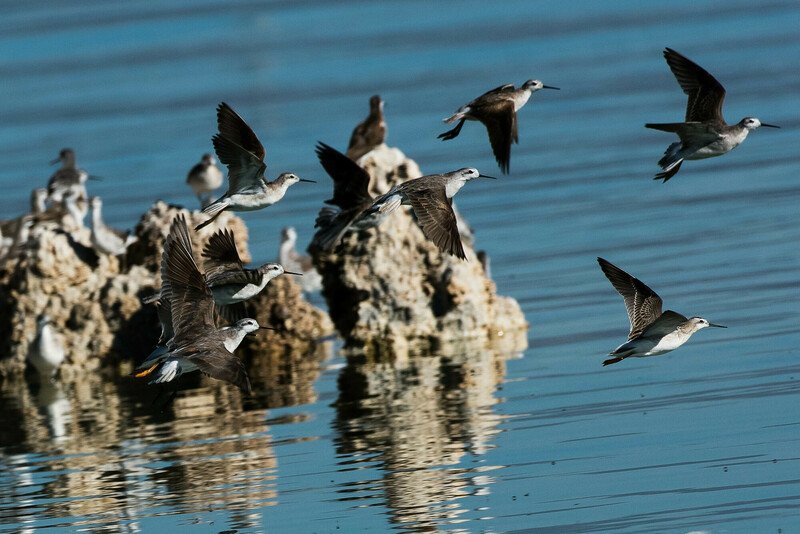For Immediate Release, October 1, 2025
|
Contact: |
Deeda Seed, Center for Biological Diversity, (801) 803-9892, [email protected] |
Lawsuit Launched to Protect Imperiled Wilson’s Phalarope Shorebirds, Who Rely on Great Salt Lake
Related Information:
Saving Wilson's phalaropeSALT LAKE CITY— The Center for Biological Diversity filed a formal notice today of its intent to sue the Trump administration for failing to determine whether the shorebird Wilson’s phalarope should be protected under the Endangered Species Act.
Author Terry Tempest Williams, local groups and community members held a rally and press conference on the dried-out lakebed of the Great Salt Lake to announce the launch of today’s federal lawsuit against the U.S. Fish and Wildlife Service. The agency has missed its legal deadline to respond to a March 2024 petition from scientists and conservation groups seeking protections for the birds under the Act.
“By offering Wilson’s phalaropes legal protection under the law, legislators, politicians and business investors will have to find ways of immediately putting water into Great Salt Lake, not according to their timeline of convenience, but the phalaropes’ radius of critical care,” said Tempest Williams. “When the landscape of Great Salt Lake and the alkaline desert that surrounds it can no longer sustain the ecological integrity and well-being of Wilson’s phalaropes, the health of all beings who call the Wasatch Front home will be at risk. The fate of a phalarope is the fate of our own species.”
Wilson’s phalaropes are inland shorebirds who rely on saline lakes in the Great Basin as critical stopovers along their migratory path to South America. The species is threatened with extinction because of the imminent collapse of these lakes, including the Great Salt Lake in Utah and Lake Abert in Oregon.
In 2022 the Great Salt Lake’s level ran so low that the food web risked collapsing because the water was too salty. Two consecutive wet winters temporarily staved off collapse. This year the Great Salt Lake has dropped to 4,191 feet, just one dry winter away from falling to its previously catastrophic low level.
“Scientists tell us unequivocally that the Wilson’s phalarope’s survival hinges on saving the Great Salt Lake,” said Deeda Seed, senior Utah campaigner at the Center for Biological Diversity. “Today the lake is 7 feet below a healthy level and the state of Utah isn’t doing nearly enough to save our beautiful life-giving lake. Time is running out for these birds and we need federal action to protect them now.”
Wilson’s phalaropes spend the spring and early summer at lakes across North America, breeding on the northern plains. Before making the 4,000-mile journey to overwinter in South America, they stop at saline lakes like the Great Salt Lake to feed on abundant invertebrates including flies and brine shrimp, storing energy for their hemispheric flight. Up to 60% of the global population uses the Great Salt Lake each summer.
Phalarope populations have fallen approximately 70% since the 1980s because of extensive habitat destruction, water diversions and persistent drought.
“By saving the phalaropes, not only are we extending love to the lake, but we are also extending love to future generations,” said Adalayde Scott, a leader with Utah Youth for Environmental Solutions. “When policymakers, politicians and the everyday person choose to save something smaller than themselves out of love, they’re showing me that they want to save me and my future, too.”
In 2022 the Great Salt Lake fell to its lowest level in recorded history because of water diversions, primarily for agriculture. It temporarily become too salty for invertebrates to successfully reproduce and survive. If the lake permanently falls to such low levels or below, this would eliminate the most important site for Wilson’s phalaropes in North America.
Over the last six years the state of Utah has worked to increase water flows into the Great Salt Lake. However, those efforts have yet to make a measurable difference because of the legal and cultural obstacles to changing water law and management. River flow to the lake needs to increase by approximately 1 million acre-feet (325 billion gallons) per year to fill the lake to a healthy level over the next 10 years. If not for the record-breaking snow year in 2023, the lake’s food web would have already collapsed.
“The lake is a keeper who’s served the living things in our mountains and valleys for generations,” said Mike Maxwell of LDS Earth Stewardship. “She’s protected us from toxic dust, provided more than half the snow that falls in our mountains, and promoted a rich biodiversity that includes us, and a host of other living things like the phalaropes. Now it’s our turn to nurture her.”
In addition to threatening wildlife, the desiccation of the Great Salt Lake is a major public health hazard. Dust blowing from the exposed lakebed pollutes air for more than 2.8 million people along the Wasatch Front. In addition to the particulate matter of the dust itself, the exposed lake sediment contains numerous toxic chemicals and heavy metals including arsenic, mercury, lead and cadmium.
“Protecting the Wilson’s phalarope, which need a healthy Great Salt Lake ecosystem to survive, is our canary in the coal mine moment,” said Jonny Vasic, executive director of Utah Physicians for a Healthy Environment. “If we allow these birds and their habitat to disappear, we will be endangering life along the Wasatch Front for humans as well.”

The Center for Biological Diversity is a national, nonprofit conservation organization with more than 1.8 million members and online activists dedicated to the protection of endangered species and wild places.

